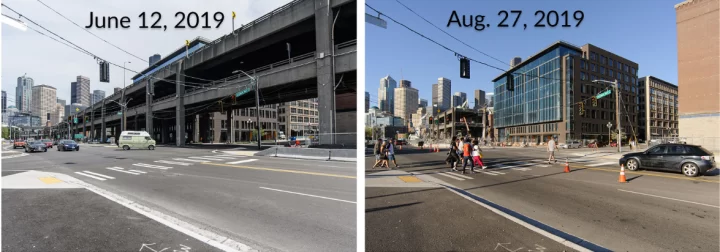The interstate highway system in the U.S. that was started in the 1950s traversed 48,000 miles and cost $425 billion. Rural and suburban neighborhoods saw these highways as a godsend, while urban dwellers saw their neighborhoods gutted and isolated. As wealthier residents fled to the suburbs, the tax base of these neighborhoods dwindled, hastening their decline.
These poorly conceived highways were placed smack dab in the middle of low-income urban neighborhoods, populated mainly by persons of color. While they have been beneficial for suburban commuters traversing these areas, these highways have destroyed communities, displacing some altogether, and created pollution and traffic that has ruined the poor communities that are left. The poorly placed urban highways have eroded the tax base in cities and have created economic death in inner-city neighborhoods, helping to increase crime, blight and abandonment.
Considering the fact that 85 percent of American workers drive to and from work every day (per the Commuting in America report, 2013), what can logically and practically be done to solve this problem? It is only in recent years that we have seen more stories in the media and statements by public officials on the negative effects of the interstate highway system, particularly to urban areas. Urban planners and designers are being called upon, finally, to provide better solutions to these urban highways. The federal government has included funding for highway removal and repurposing of excess roadway capacity through the Infrastructure Investment and Jobs Act. One billion dollars will be focused on reconnecting neighborhoods that have been cut off by these urban highways, and making sure that new projects will increase opportunity, advance racial equity and environmental justice, and promote affordable access.
Which Highways Are in the Greatest Need of Fixing?
The Congress for the New Urbanism identified 15 highways across the United States in 2021 that have become obsolete and are in dire need of transformation. These highways have created problems for those still living near them, and have become liabilities to their neighborhoods. Alternatives have been envisioned to remedy the problems created by each of these failed highways. They are:
- The Brooklyn-Queens Expressway, New York, NY
- Claiborne Expressway (I-10), New Orleans, LA
- Inner Loop North, Rochester, NY
- I-244, Tulsa, OK
- I-275, Tampa, FL
- I-345, Dallas, TX
- I-35, Austin, TX
- I-35, Duluth, MN
- I-5, Seattle, WA
- I-81, Syracuse, NY
- I-980, Oakland, CA
- Kensington Expressway, Buffalo, NY
- North Loop (I-35/70), Kansas City, MO
- Scajaquada Expressways, Buffalo, NY
- The Great Highway, San Francisco, CA
What Can Urban Planners Do to Help?
Fixing the mistakes that these urban highways have created does not necessarily involve abandoning the highways altogether. Included within the Infrastructure Investment and Jobs Act is money that will help to solve these problems. Some highways will need to be removed altogether, while others can be converted to more urban-friendly streets. Rethinking urban highways affects more than just the immediate community surrounding them. When a downtown area of a city thrives, the entire economic region feels the benefits and reaps the rewards.
Some examples of urban highways that have recently been transformed to create safer streets within these areas include:
- Inner Loop East, Rochester, NY – traffic hazards were eliminated, and a barrier to redevelopment in the important East End of Rochester was removed. The new Union Street that was created features improved pedestrian and cycling infrastructure. New businesses are being built there to enhance the positive economic impact.
- West Side Highway/9A, New York, NY – a deteriorating highway was transformed into a street that makes pedestrians and cyclists a priority. Since the improvements to this public space, development and tourism have increased in the area.
- Reno, NV- a cap was created over a rail line where highway removal was not an option due to existing traffic levels. This eliminated a divide between neighborhoods that were traversed by a highway, placing a cap over the current highway and enhancing that cap with park space.
- Albany, NY skyway project – a highway off ramp that was not well-used was changed into an elevated park with pedestrian and cycle connections to the waterfront area.
- Cap at Union Station, Columbus, OH – an existing bridge was lined with storefronts, making the walk along the bridge more enjoyable for pedestrians and reducing road noise.
- I-277on- and off-ramps, Charlotte, NC- 10 acres of land was made available after on-and off-ramps were reconfigured to support the construction of the NASCAR Hall of Fame, leading to another $2 billion in new construction.
- Woodall Rogers Freeway, Dallas, TX – a cap called Klyde Warren Park was placed over the freeway, costing $110 million to construct, but generating over $2.5 billion in economic impact.
How Can These Problems Be Avoided in Future Planning Projects?
Time has taught us that placing highways through urban areas is not the answer to urban growth. As urban planners help to design new projects, they must be sure to do certain things to ensure equitable planning and outcomes for all persons living within communities. These include:
- Engaging the local community in the planning project through compelling, relevant activities. Community events and focus groups are great for gathering feedback from the community.
- Collecting and prioritizing data about the areas can produce better results.
- Establishing community-specific goals and possible alternatives.
- Listening and learning how to best serve the neighborhoods in order to build community support, leadership and political power
- Considering all of the various design options
- Investing in lasting value, making sure a return on investment is maximized
- Measuring the progress of a project and developing a process to assess change will help to achieve project goals and success
To learn more about the career, click here to learn how to become an Urban Planner.


